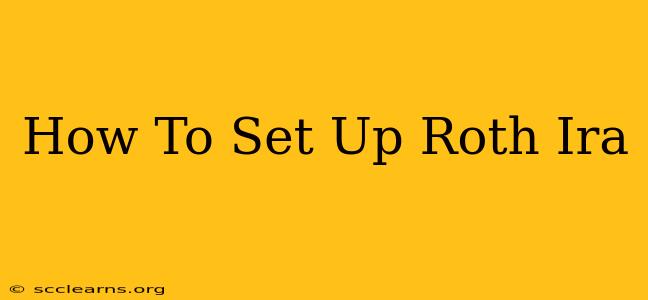Opening a Roth IRA is a smart move for securing your financial future. But knowing where to start can be daunting. This comprehensive guide breaks down the process into simple, manageable steps, ensuring you're well-equipped to begin building your retirement nest egg.
Understanding the Roth IRA
Before diving into the setup process, let's quickly clarify what a Roth IRA is and why it's beneficial. A Roth IRA is a retirement savings account where your contributions are made after taxes. This means you pay taxes on your contributions now, but your withdrawals in retirement are tax-free. This contrasts with a traditional IRA, where contributions are tax-deductible now, but withdrawals are taxed in retirement.
Key Advantages of a Roth IRA:
- Tax-free withdrawals in retirement: Enjoy your retirement savings without the tax burden.
- Potential for tax-free growth: Your investments grow tax-deferred, meaning you don't pay taxes on the gains until you withdraw them (and with Roth IRAs, you don't pay taxes on withdrawals).
- Flexibility: While early withdrawals are generally penalized, you can withdraw your contributions (but not earnings) at any time without penalty.
Step-by-Step Guide to Setting Up Your Roth IRA
Now, let's get down to the specifics of opening your Roth IRA account.
Step 1: Determine Your Eligibility
Before you even begin, it's crucial to ensure you meet the eligibility requirements. The contribution limits change yearly, so check the current IRS guidelines. Generally, you can contribute to a Roth IRA if your modified adjusted gross income (MAGI) is below a certain threshold. For 2023, these limits are:
- Single: $153,000
- Married Filing Jointly: $228,000
These limits may affect your ability to make full contributions; you may still be eligible to contribute partially if your income is above the limit. Consult a financial advisor or the IRS website for the most up-to-date information.
Step 2: Choose a Roth IRA Provider
Selecting the right provider is vital for managing your Roth IRA effectively. Several options are available, each with its own fees, investment choices, and user interface:
- Brokerage Firms: These firms (e.g., Fidelity, Schwab, Vanguard) offer a wide range of investment options, often with low fees and robust online platforms.
- Banks and Credit Unions: These institutions typically offer simpler Roth IRA options with less investment flexibility but may be more convenient for those preferring a traditional banking relationship.
Consider factors like investment options, fees, customer service, and user-friendliness when making your decision.
Step 3: Open Your Account
Once you've chosen a provider, the account opening process is usually straightforward. You will typically need to:
- Provide personal information: This includes your Social Security number, date of birth, and address.
- Choose your investment options: Decide how you want to invest your contributions – stocks, bonds, mutual funds, etc. Many providers offer pre-built portfolios tailored to different risk tolerances.
- Fund your account: Transfer funds from your bank account or other financial accounts to initiate your contributions.
Step 4: Make Your Contributions
Roth IRA contributions for 2023 are capped at $6,500. Individuals age 50 and older can make additional "catch-up" contributions. Remember to stay informed about annual contribution limits, as they can change.
Step 5: Monitor and Adjust Your Investments
Regularly review your Roth IRA investments to ensure they align with your long-term financial goals and risk tolerance. As your circumstances change, you may need to adjust your investment strategy.
Frequently Asked Questions (FAQs)
-
What if I exceed the income limits? You may still be able to contribute to a Roth IRA, but your contribution limit may be reduced or you may be ineligible to make a full contribution. Consult a financial professional for personalized advice.
-
Can I contribute to a Roth IRA and a 401(k)? Yes, many people contribute to both a Roth IRA and a 401(k) or other employer-sponsored retirement plan.
-
What are the tax implications of withdrawing from a Roth IRA? Qualified withdrawals (taken after age 59 1/2 and after at least 5 years of contributions) are tax-free.
Opening a Roth IRA is a significant step towards securing your financial future. By following these steps and doing your research, you'll be well on your way to building a comfortable retirement. Remember to consult with a financial advisor for personalized guidance tailored to your individual financial situation.

